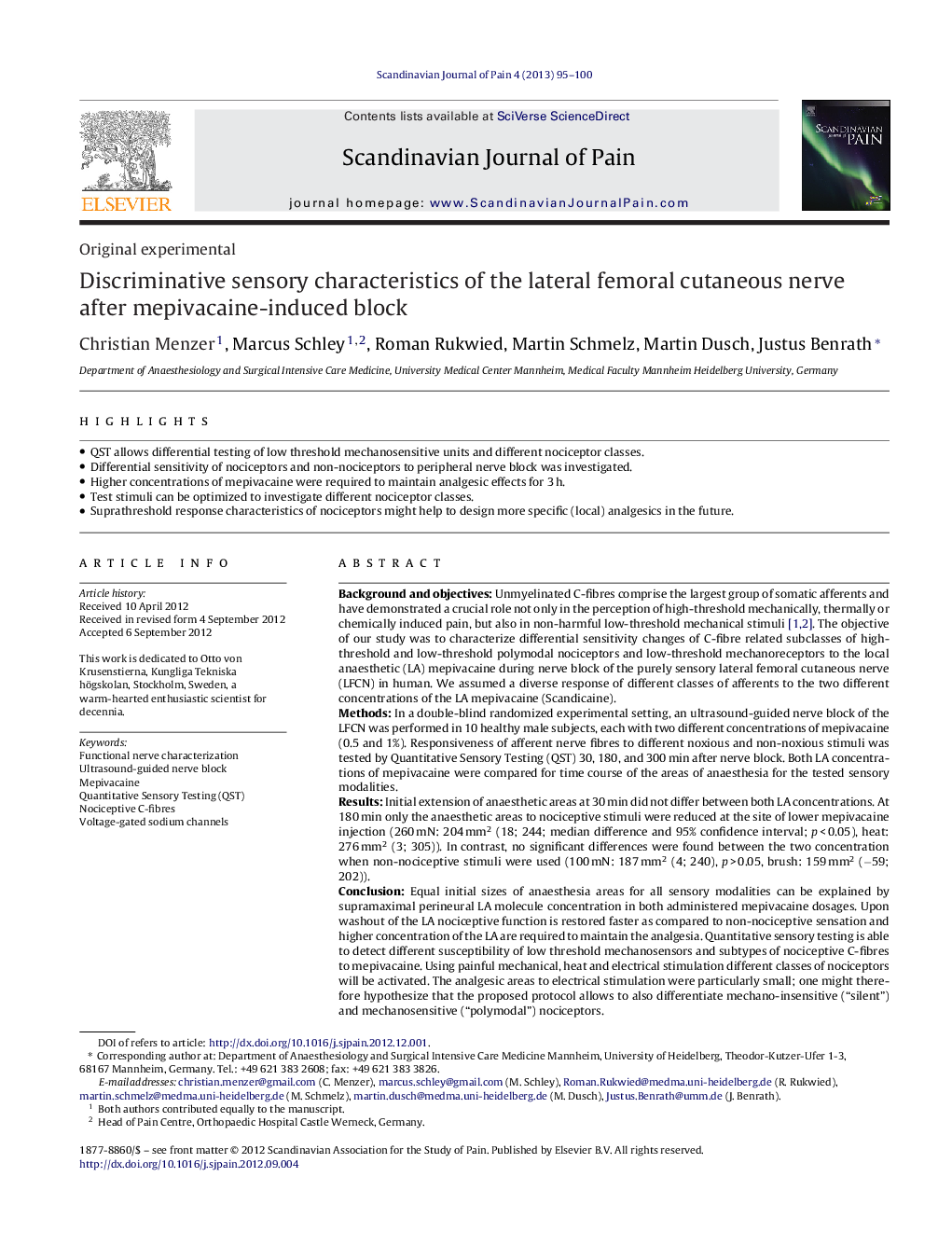| کد مقاله | کد نشریه | سال انتشار | مقاله انگلیسی | نسخه تمام متن |
|---|---|---|---|---|
| 2770744 | 1567821 | 2013 | 6 صفحه PDF | دانلود رایگان |

• QST allows differential testing of low threshold mechanosensitive units and different nociceptor classes.
• Differential sensitivity of nociceptors and non-nociceptors to peripheral nerve block was investigated.
• Higher concentrations of mepivacaine were required to maintain analgesic effects for 3 h.
• Test stimuli can be optimized to investigate different nociceptor classes.
• Suprathreshold response characteristics of nociceptors might help to design more specific (local) analgesics in the future.
Background and objectivesUnmyelinated C-fibres comprise the largest group of somatic afferents and have demonstrated a crucial role not only in the perception of high-threshold mechanically, thermally or chemically induced pain, but also in non-harmful low-threshold mechanical stimuli [1] and [2]. The objective of our study was to characterize differential sensitivity changes of C-fibre related subclasses of high-threshold and low-threshold polymodal nociceptors and low-threshold mechanoreceptors to the local anaesthetic (LA) mepivacaine during nerve block of the purely sensory lateral femoral cutaneous nerve (LFCN) in human. We assumed a diverse response of different classes of afferents to the two different concentrations of the LA mepivacaine (Scandicaine).MethodsIn a double-blind randomized experimental setting, an ultrasound-guided nerve block of the LFCN was performed in 10 healthy male subjects, each with two different concentrations of mepivacaine (0.5 and 1%). Responsiveness of afferent nerve fibres to different noxious and non-noxious stimuli was tested by Quantitative Sensory Testing (QST) 30, 180, and 300 min after nerve block. Both LA concentrations of mepivacaine were compared for time course of the areas of anaesthesia for the tested sensory modalities.ResultsInitial extension of anaesthetic areas at 30 min did not differ between both LA concentrations. At 180 min only the anaesthetic areas to nociceptive stimuli were reduced at the site of lower mepivacaine injection (260 mN: 204 mm2 (18; 244; median difference and 95% confidence interval; p < 0.05), heat: 276 mm2 (3; 305)). In contrast, no significant differences were found between the two concentration when non-nociceptive stimuli were used (100 mN: 187 mm2 (4; 240), p > 0.05, brush: 159 mm2 (−59; 202)).ConclusionEqual initial sizes of anaesthesia areas for all sensory modalities can be explained by supramaximal perineural LA molecule concentration in both administered mepivacaine dosages. Upon washout of the LA nociceptive function is restored faster as compared to non-nociceptive sensation and higher concentration of the LA are required to maintain the analgesia. Quantitative sensory testing is able to detect different susceptibility of low threshold mechanosensors and subtypes of nociceptive C-fibres to mepivacaine. Using painful mechanical, heat and electrical stimulation different classes of nociceptors will be activated. The analgesic areas to electrical stimulation were particularly small; one might therefore hypothesize that the proposed protocol allows to also differentiate mechano-insensitive (“silent”) and mechanosensitive (“polymodal”) nociceptors.ImplicationsQST is a non-invasive method to functionally examine sensory modalities and their pharmacological modulation in humans. The method is sufficiently sensitive to differentiate the analgesic properties of mepivacaine at 0.5 and 1% and might also be adequate to different classes of nociceptors. Further development of nociceptive stimuli including supra-threshold encoding characteristics will enable to investigate peripheral analgesic effects more specifically and thus might help to design new analgesics with preferential effect on high frequency discharge of nociceptors.
Journal: Scandinavian Journal of Pain - Volume 4, Issue 2, April 2013, Pages 95–100